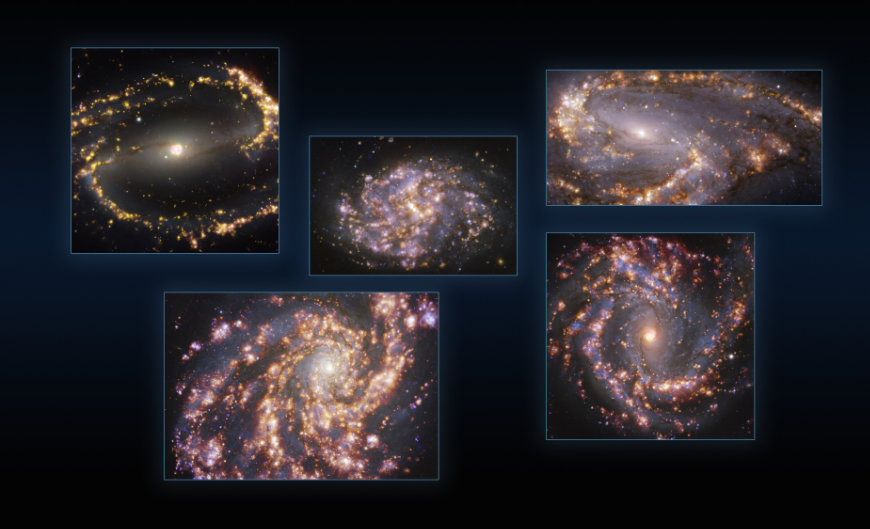Insight into star formation in other galaxies
New observations of nearby galaxies, for data very large telescope European Southern Observatory ESO and des Large Atacama Group Millimeter / Meter ALMA shows a real fireworks display of star formation in nearby galaxies. In this way, researchers hope to learn more about the process of forming new stars.
 This image combines observations of nearby galaxies NGC 1300, NGC 1087, NGC 3627 (top, left to right), NGC 4254, and NGC 4303 (bottom, left to right) made with the Multi-Unit Spectrograph Explorer (MUSE) On ESO’s Very Large Telescope (VLT). Each individual image is a set of observations made at different wavelengths of light to map star clusters and warm gases. The golden glow mainly corresponds to clouds of ionized hydrogen, oxygen, and sulfur gas, which indicate the presence of newly born stars, while the blue areas in the background show the distribution of slightly older stars. [Groansicht] |
Astronomy knows that stars are born in gaseous clouds, but what stimulates star formation and how galaxies as a whole play a role in this remains a mystery. To understand this process, the research team observed several nearby galaxies with powerful ground and space telescopes and examined regions of different galaxies involved in star formation.
“For the first time we are solving individual star-forming regions with a variety of regions and environments in a selection of galaxies that well represent the different variables,” says Eric Emsellem, an astronomer at ESO’s European Southern Observatory in Germany and the university. Lyon, France. made notes on very large telescope (VLT) from ESO as part of the PHANGS (High Angle Resolution Physics of Nearby Galaxies) project. “We can directly observe the gas from which stars are formed. We see the same young stars, and witness their evolution in different stages.”
Emsellem and his team have now published the latest set of images of galaxies recorded with the VLT’s MUSE (Multi-Unit Spectrograph) instrument. They used MUSE to blast newborn stars and the warm gas around them, which is lit and heated by stars and is a clear indication of continued star formation. The PHANGS collaboration, headed by Eva Schinnerer of the Max Planck Institute for Astronomy (MPIA), combined these new images with observations of the same galaxies that were used with Large Atacama Group Millimeter / Meter (ALMA) and was released earlier this year.
The ALMA radio telescope network, also located in Chile, is particularly suitable for mapping cold gas clouds, that is, those objects in galaxies that provide the raw materials from which stars are formed. MUSE and ALMA complement each other in identifying and examining regions of star formation within the observed galaxies. “By combining MUSE and ALMA images, we can investigate how previous generations of stars influence the process of forming a new star cluster,” explains Ismail Bessa, an MPIA doctoral student working on the PHANGS project. “This helps us better understand what stimulates, amplifies or slows down the birth of new stars.”
The resulting images are impressive and offer a colorful glimpse into stellar nurseries in our neighboring galaxies. “There are so many mysteries we want to solve,” says Catherine Kreckel of the University of Heidelberg and a member of the PHANGS team. “Are stars born often in certain regions of the host galaxies? And if so, why? After stars are born, how does their evolution affect the formation of new generations of stars?”
Astronomers can now answer these questions thanks to the wealth of MUSE and ALMA data collected by the PHANGS team. MUSE produces spectra for every location in its field of view – the “barcodes” that astronomers scan to identify properties and characteristics of cosmic objects – thus providing much richer information than previous instruments. For the PHANGS project, MUSE observed 30,000 warm gas nebulae and collected about 15 million spectra from different galactic regions. ALMA’s observations, in turn, have enabled astronomers to map about 100,000 cold gas clouds in 90 nearby galaxies, thus creating an unprecedentedly detailed atlas of stellar germ cells in the nearby universe.
In addition to ALMA and MUSE, observations from the space telescope are also part of the PHANGS project Hubble included. Various observatories were chosen so that the team could examine our galactic neighbors at different wavelengths (visible, near-infrared and radio). Each wavelength range considers different parts of the observed galaxies. Their combination allows researchers to study the different stages of star formation – from the formation of stellar birthplaces to the beginning of star formation themselves to the question of how newly born stars eventually destroy their breeding grounds.
For the first time, PHANGS offers the potential to develop such a complete picture by providing views sharp enough to make visible the individual clouds, stars, and nebulae that make up star circles. “MUSE’s sharp images show, for example, the effect of newly emerging stars on the material around them. This closer look helps us understand how stars affect their surroundings, for example through stellar winds,” says MPIA’s Francesco Santoro. “Above all, we want to investigate how such interactions contribute to the gas cycle in the interstellar medium, the raw materials of stars, and how they affect future generations of stars.”
There is still a lot to be done, even for the next generation of telescopes: “As amazing as PHANGS is, the accuracy of the maps we create is only enough to identify and separate individual star-forming clouds. But they are still not good enough to see what’s happening in The interior is detailed,” Shenrer confirms. “New observations from our team and others are pushing the boundaries of what is possible in this direction, so that we still have decades of exciting discoveries ahead.”
|
|
|
|
|
|






